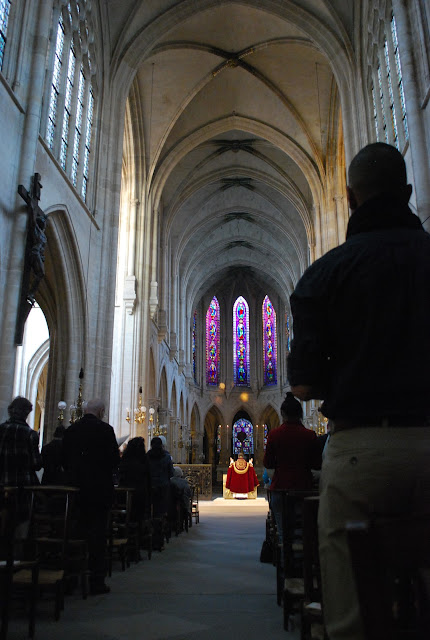 |
| In contrast, Parisian restaurants are open. |
 |
| So are all the shops. |
My family usually stays in Manila for the traditional "visita iglesia" and stations of the cross because my father got a kick out of driving on the abandoned streets of the typically gridlocked city. Last year it felt strange, because tradition (birthdays, Christmas, new year's day) tends to magnify my father's absence. This year it felt even stranger because I did it alone, in a city I scarcely know. But when one is alone and lost, one can only turn to tradition.
 |
| The men in white capes shield the "couronne" from snap-happy tourists. To the right, on top of the red cloth are the nails and cross fragments. |
Once inside, I lined up at the center aisle which turned out to be the line going towards the thorns. I made it just in time for the 3pm service (in French, English, Spanish, Italian and German) and an usher gave me a guide. In a matter of minutes I was singing in French too. And then suddenly, I was in front of the relic.
When my mother was here, we went to Sainte-Chapelle to see the church built just to house the crucifixion relics. She had hoped to see the crown of thorns, the fragment of the cross and the nails that St. Helen was said to have recovered from Jerusalem. But the church only reveals it to the public on certain holidays and first Fridays of the month, so she wasn't able to see them.
 |
| The faithful kiss or wipe their fingers on the glass that exposes the Thorns. |
The service lasted an hour. I got a seat around the back and stayed until the end, when a woman I helped out with the sequencing of songs wished me Bonne Pâques - Happy Easter.
Next, I went to the oldest church in Paris, the Sainte-Julien-le-Pauvre, which stood just across the street and behind the oldest tree in Paris.
 |
| The church of Saint Julian the Poor, who talked to a deer, killed his parents, then met Jesus on a boat and became a saint. |
They were holding a funeral service for Jesus, hence the wreath of roses in front.
 |
| When I came it was practically empty. |
 |
| The church itself is an artifact. |
A few streets away at the Saint-Severin, the rosary was being recited in French.
It was all quiet at the Saint-Etienne-du-Mont. It used to be the abbey of St. Genevieve, the patron saint of Paris. King Louis XV ordered the erection of a big basilica for her relics (adjacent to the church) and rededicated the existing church to St. Etienne. But later secularization turned the basilica into the Pantheon - a mausoleum for notable French men and woman (Marie Curie), and it was back to the old church for St. Genevieve.
 |
| Sadly, many statues were destroyed by revloutionaries, and St. Genevieve's relics were thrown in the river or burned. |
 |
| The cross is covered in cloth. |
 |
| The shrine of St. Genevieve, patron saint of Paris. On the left is her tomb, visited by John Paul II during World Youth Day. |
I had some trouble finding the Notre Dame du Liban because until then, I had been relying on the sight of church towers to guide me when my map reading skills failed. The church was under an apartment building, and definitely not what I expected a church facade to look like.
 |
| People come in with bouquets of flowers, or buy some from a florist just outside the main church entrance. |
The churchgoers here are mainly Lebanese Maronites.
 |
| Who would have known this could be under an apartment complex? |
 |
| There was also a TV crew. |
Further down the road was the Church of the Val-de-Grâce, one of the jewels of French architecture. The inscription on the portico reads: "To Virgin Mary for the occasion of Jesus' birth," or something to that effect.
After the Church of St. Genevieve was turned into the Pantheon, the former church's organ was transferred here.
On Rue Mouffetard, the ancient road leading to Italy, is the Church of Saint-Médard. Click the link for an interesting account of its history.
 |
| The church that stands here now was allegedly built in the 7th century; an earlier church in the grounds made circa 500 was destroyed by the Normans. |
 |
| It's behind the trees in this pretty plaza. |
This beautiful structure in front of La Louvre was built in the 6th century by the Merovingians, but there is little evidence of their influence.
Two blocks away is St. Eustache, where Louis XIV took his first communion, Mozart held his mother's funeral, and Moliere got married. It's a very beautiful church, with heart-shaped glass on the windows. Guide books prominently feature the statue L'Ecoute in front.
There was a service and a choir sang after each reading.
For now at least, I am free to exercise my ideology; but with religion becoming less and less popular, I'm not sure how long before churches become mere tourist attractions and relics themselves - and prayers reduced to mere whispers in caves.













No comments:
Post a Comment